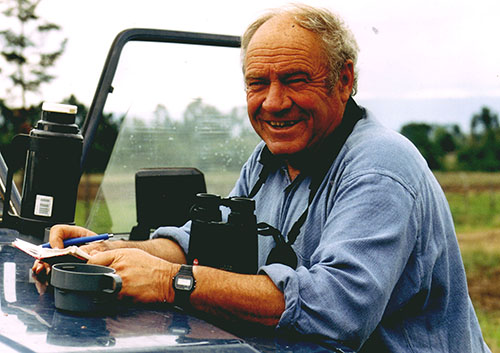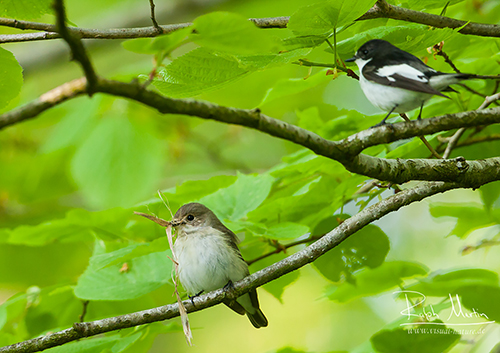Evolutie zorgt voor aanpassing in migratieklok trekvogels
De timing van de voorjaarsmigratie is cruciaal voor vogels. Wanneer ze te laat in hun broedgebied aankomen kan ze dat duur komen te staan. In 1981 liet de Duitse onderzoeker Eberhard Gwinner zien dat een interne klok verantwoordelijk is voor de juiste timing van de jaarlijkse trek van bonte vliegenvangers. Door dit experiment twintig jaar later te herhalen, kon RUG-onderzoeker Barbara Helm aantonen dat evolutie heeft gezorgd voor aanpassing van deze klok aan klimaatverandering. De resultaten zijn op 24 oktober gepubliceerd in het wetenschappelijk tijdschrift Current Biology.
De bonte vliegenvanger brengt de winter door in Afrika en keert in het voorjaar terug naar Europa om te broeden. De timing van de trek is belangrijk, die moet er voor zorgen dat de vogels maximaal kunnen profiteren van een korte piek in de aantallen rupsen, hun basisvoedsel. Maar hoe weten ze dat het tijd is om terug te vliegen? In 1981 haalde Edward Gwinner vliegenvangers die net uit het ei waren gekropen uit nesten om ze in een laboratorium te laten opgroeien. Daar observeerde hij ze bijna een jaar lang.
“Gwinner mat de activiteit van de vogels in kooien de waren afgeschermd van de buitenwereld. Hij gebruikte schakelaars op de zitstokken om beweging te meten en keek naar verschijnselen als de rui en de groei van voortplantingsorganen, die horen bij de jaarlijkse cyclus”, legt prof. dr. Barbara Helm uit. Rond de tijd van de trek werden de gekooide vogels rusteloos, vooral ’s nachts. Andere kenmerken in gedrag en fysiologie die horen bij trek en voortplanting waren ook te zien. “De conclusie van het onderzoek was dat de vogels een interne klok hebben die tijdens het jaar het gedrag activeert dat hoort bij de trek, deels in reactie op signalen uit de omgeving.”

Klimaatverandering
Het experiment van Gwinner werd een klassieker. Dus toen duidelijk was dat de start van het voorjaar verschoof onder invloed van klimaatverandering, ontstond het idee om het te herhalen. “Dit gebeurde in 2002, in de originele kooien en met de oorspronkelijke instrumenten naast nieuwere technieken”, vertelt Helm, die dit replicatie-experiment samen met Gwinner uitvoerde. “Uniek dat de oorspronkelijke opstelling nog beschikbaar was, net als de ruwe data uit het eerste experiment”, vervolgt zij. Daardoor waren de twee experimenten goed te vergelijken. Kort na het einde van het experiment overleed Gwinner. Zijn lab werd opgedoekt en de analyse liep ernstige vertraging op doordat Barbara Helm elders projecten ging doen. Pas vorig jaar toen ze aan de RUG ging werken, kreeg ze tijd om een artikel over het herhaalde onderzoek te schrijven.
Eerder op trek
“Onze hypothese was dat de veranderingen het meest zichtbaar zouden zijn rond de trek in de lente, omdat daar de invloed van klimaatverandering het sterkst is”, legt Helm uit. En inderdaad, het eind van de ruiperiode in de winter en de start van de onrust die kenmerkend is voor trek waren in het voorjaar met 9,3 dagen naar voren geschoven, net als de groei van de geslachtsorganen (die in de winter krimpen). Veranderingen die samenhangen met de trek in de herfst waren juist iets vertraagd.
De resultaten suggereren dat de jaarlijkse klok is aangepast. “Dit zagen we bij vogels in een laboratoriumkooi. Maat hoe zat dat bij dieren in het wild?” Een collega wees Barbara Helm op twee amateur-wetenschappers, een echtpaar dat als al sinds 1973 waarnemingen van vliegenvangers deed; zij hadden onder meer alle jonge vliegenvangers in hun omgeving geringd. “Ze wonen ongeveer honderd kilometer van de plek waar wij onze vogels hadden gevangen, in een vergelijkbaar landschap. En ze bezaten gegevens over de timing van de voortplanting van de bonte vliegenvanger die 46 jaar terug gaan.”

Eerste ei elf dagen eerder
Vergelijkingen met de resultaten uit het laboratoriumonderzoek lieten een zelfde trend zien in het veld: daar legden vliegenvangers hun eerste ei elf dagen eerder dan in 1981. Dieter en Ute Hoffman, het echtpaar dat de vogels had gevolgd, zijn nu medeauteurs van het wetenschappelijke artikel. Een andere auteur is Benjamin van Doren van de Universiteit van Oxford, die de statische analyses heeft verzorgt.
Vliegenvangers versus koolmezen
De uiteindelijke conclusie in het artikel is dat er een vorm van fenotypische evolutie is opgetreden, wat heeft geleid tot aanpassing van de interne klok die de timing van de trek verzorgt. “Het goede nieuws is dat de vogels zich beter kunnen aanpassen dan verwacht”, zegt Helm. Maar, zo voegt ze er aan toe, het is niet duidelijk hoe ver die aanpassing kan gaan. En er zijn andere problemen. Onderzoek van RUG biologen dat eerder dit jaar verscheen, laat zien dat de verschuiving in aankomstdatum van de vliegenvangers kan leiden tot dodelijke confrontaties met koolmezen.
De replicatiestudie is inmiddels ook alweer bijna twintig jaar oud. Is het niet tijd voor nog een herhaling? Dat zit er vermoedelijk niet in volgens Barbara Helm. “Toen het lab van Gwinner werd gesloten, zijn alle instrumenten afgevoerd, dus het is onmogelijk om de studie met met dezelfde apparatuur te herhalen.”
Referentie: Barbara Helm, Benjamin M. Van Doren, Dieter Hoffmann5 & Ute Hoffmann: Evolutionary response to climate change in migratory pied flycatchers. Current Biology 4 November 2019 (online: 24 October): DOI 10.1016/j.cub.2019.08.072
Meer nieuws
-
25 november 2025
Veertien Groningse bètastudenten winnen KHMW Jong Talentprijzen
-
25 november 2025
NWO ENW-M subsidies voor drie FSE onderzoekers
